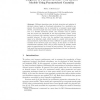Free Online Productivity Tools
i2Speak
i2Symbol
i2OCR
iTex2Img
iWeb2Print
iWeb2Shot
i2Type
iPdf2Split
iPdf2Merge
i2Bopomofo
i2Arabic
i2Style
i2Image
i2PDF
iLatex2Rtf
Sci2ools
HYBRID
2001
Springer
2001
Springer
Diagnosis of Physical Systems with Hybrid Models Using Parametrized Causality
Efficient algorithms exist for fault detection and isolation of physical systems based on functional redundancy. In a qualitative approach, this redundancy can be captured by a temporal causal graph (TCG), a directed graph that may include temporal information. However, in a detailed continuous model, time constants may be present that are beyond the bandwidth of the data acquisition system, which leads to incorrect fault isolation because of a difference in observed and modeled behavior. To solve this, the modeled time constants can be taken to be infinitely small, which results in a model with mixed continuous/discrete, hybrid behavior that is difficult to analyze because the causality of the directed graph may change. In this paper, to avoid the combinatorial explosion when using a bank of TCGs in parallel, causal paths are parametrized by the state of local switches. The result is a hybrid model that produces parametrized predictions that can be efficiently matched against observ...
| Added | 29 Jul 2010 |
| Updated | 29 Jul 2010 |
| Type | Conference |
| Year | 2001 |
| Where | HYBRID |
| Authors | Pieter J. Mosterman |
Comments (0)

